Why Does Pepperoni Curl?
What is pepperoni curl? What makes it happen, and how do you maximize it? The answer is far more fascinating than you may think.
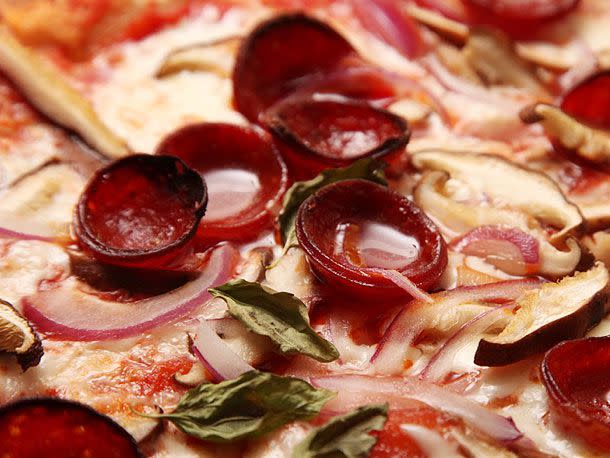
Today's installment of The Pizza Lab presents what is probably the most important work of my career. Nay, my life. It's a story of such unparalleled importance that it makes pressing international issues like comparative baking surfaces and cold fermentation seem trivial in comparison. I'm talking about pepperoni curl. What it is, what makes it happen, and how to maximize it.
It's far more fascinating than you may think.
There are times when I'll head into a bog-standard New York slice joint, see those pre-cooked squares with their flat disks of pepperoni, watch some poor sap order them, and think to myself: Ah, you've fallen victim to one of the two classic blunders, the most famous of which is "never question your pizza toppings in Asia," but only slightly less well known is this: "Never order a Sicilian when you spy flat-laying pepperoni on the line."
To me, flat pepperoni just doesn't fit the bill. It sits there, wan and pliable, its grease spreading over the top of semi-coagulated cheese like an oil spill, dripping off the edges of a slice, making the whole endeavor so treacherous that some folks even resort to blotting with paper napkins.
On the other hand, what you should be having is this:
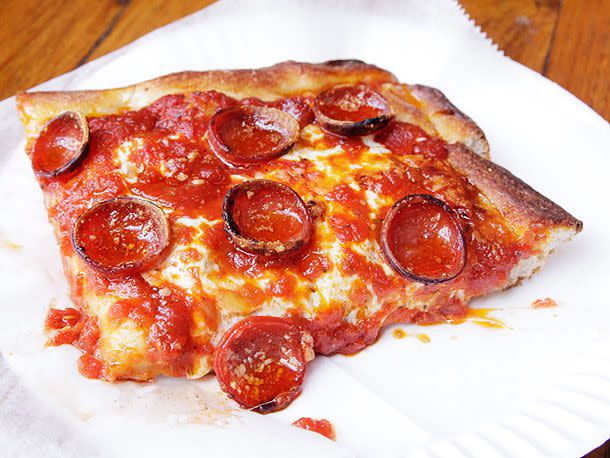
J. Kenji Lopez-Alt
As the pizza bakes, the edge of the pepperoni curls upwards, forming a distinct lip. Once exposed like this, the lip cooks faster than the base, which is insulated by the cheese and crust, and thus crisps and renders its fat faster. This fat drips down into the center of the cup. What you're left with is a gloriously flavorful little sip of pepperoni grease, neatly contained within its own, crisp-lipped edible container. The browned lip takes on an almost bacon-like quality—melt-in-your-mouth crunchy. It's one of the true joys of a pepperoni pizza, and once you've experienced it, plain old flat pepperoni just won't do.
I first read the term "grease chalice" in the winning entry of a "pie-ku" contest run by Adam Kuban way back in 2005, before Serious Eats even existed. The winning entry:
"crisp pepperoni
edge curled from heat
a chalice of sweet, hot oil"
Have you ever read anything so beautiful or profound?
A few months back, the Serious Eats Community charged us with reporting on what makes pepperoni cup when you cook it.
A number of theories were thrown around in that thread, and after talking to a couple of experts, I've heard a few more. The question it, which one is correct?
For the past few months, I've been meticulously testing various types, brands, styles, thicknesses, orientations, configurations, amalgamations, and fibrillations of pepperoni in order to figure it out. Here's what I got:
The Theory Of The Pepperoni Curl
There are a few basic hypotheses that try to explain pepperoni curl. Two seem intuitive, while others require a bit more specialized knowledge. The first two are:
Hypothesis #1: It's the thickness. When you cook a piece of pepperoni on a pizza, the top of the pepperoni is exposed to the air of the oven and heats faster than the bottom, which is insulated from heat by the cheese and the dough (both are fantastic insulators, bread because of its air spaces, cheese because of its fat content). The thicker the slice, the bigger the difference in heating rate between the top of the slice and the bottom. As the top cooks faster than the bottom, it shrinks more, causing the pepperoni to curl. Once it starts curling and the edges lift slightly and start cooking faster themselves, that differential is exacerbated causing it to cup even more severely.
Hypothesis #2: It's the casing. Most high-quality pepperoni sticks are made by stuffing a spiced pork-and-beef sausage mix into a casing, either natural pork casing, or a collagen-based casing designed to act like a natural casing. As we know with natural casing hot dogs and sausages, those casings shrink up when cooked (that's part of what makes a sausage plump as you cook it). Because the edges of the pepperoni shrink more than the center, the slice buckles and cups.
These both seem like very valid, and luckily, very testable hypotheses, so we'll start with them before moving on.
Hypothesis #1: The Thickness
To test this, I cooked slices of pepperoni on a pizza in varying thicknesses. I used a Natural casing Boar's Head pepperoni stick, hand sliced for this test.
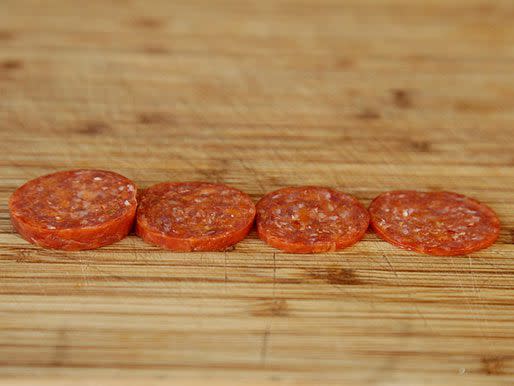
I used calipers to precisely measure the pepperoni slices, testing 8 different thicknesses that ranged from .25 inches (6.4 millimeters), all the way down to .05 inches (1.3 millimeters)

I placed them all on top of a single pie I made using my Basic New York-Style Pizza Dough with a simple sauce and dry mozzarella cheese, then slipped it on top of a pre-heated baking steel.
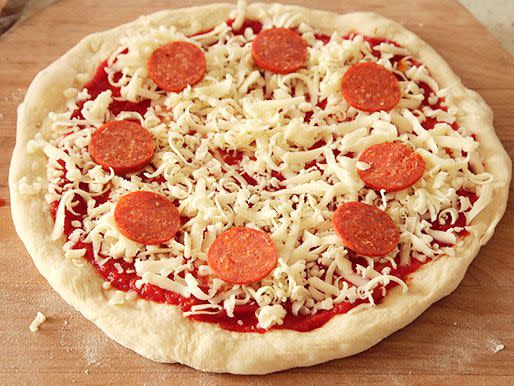
5 minutes later, I had my results.
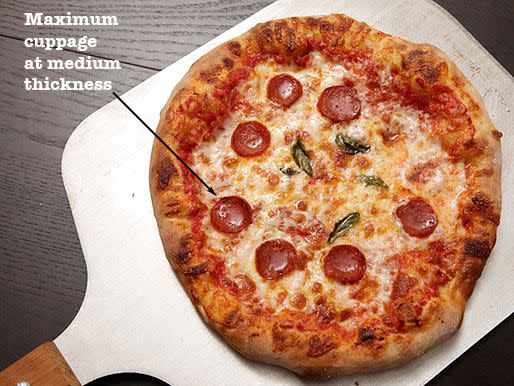
The first thing you'll notice is that the thinnest slice actually got swallowed whole by the cheese. Oops.
I measured the amount of cuppage on each slice visually, and by measuring the height to which the highest point of the cup curled up beyond the interior base of the cup, which would correspond to the original height of the cup edge.
Turns out that thickness does have an effect on pepperoni curl, but not all that much. The very thinnest slices showed a conservative amount of curling, not really picking up until the .1 inch (2.5 millimeter) range, but after that, cuppage was excellent all the way until we got to the very thickest slice, which was simply too bulky and thick to be able to curl properly. You could see it trying, but failing:
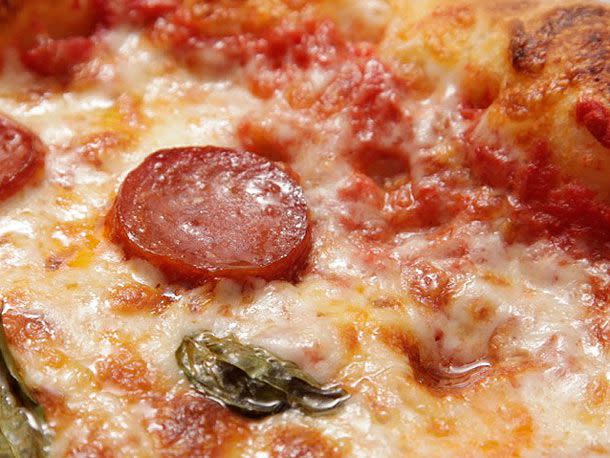
While the test may answer a few questions, I've certainly seen slices of pepperoni in that thickness range that don't do any curling at all, so there has to be more to the story than just thickness.
Let's move on.*
*For an interesting computer simulation visualization of this model, please jump to the bottom of this post!
Corollary to Hypothesis #1: Heat Source Direction
Part of the thickness hypothesis posits that a directional heat source is required. That is, the pepperoni curls only when heated from one side, and it curls in the direction of the heat source. To confirm this, I did another quick test, frying six slices of pepperoni in a skillet (they were placed in different orientations so that some faced up while others faced down relative to each other).

As expected, they all curled downwards (towards the heat source), confirming that there is something to the first hypothesis after all.
Hypothesis #2: The Casing
I've seen pepperoni sold in three forms: natural casing, collagen casing, and casing-free. To get a bit more info on these style, I spoke with Eric Cherryholmes of the Ezzo Sausage Company of Columbus OH,* one of the finest pepperoni makers and wholesale distributors around (their product is not available retail, but you've probably had it on a pizza before).
Eric Cherryholmes has since left Ezzo
According to Eric, the cupping has everything to do with the casing. As he said to me, "our Classic pepperoni is stuffed in a fibrous casing that gets stripped before slicing and lays flat when cooked. The GiAntonio [their brand name] is stuffed in collagen casing and gets sliced in its casing and applied. The casing shrinks when cooked, causing the cupping of the product."
I had Eric send me a few sticks of his pepperoni (and man, was it tasty!), asking him to leave all of the casings—including the fiber casing—intact so that I could get a look at them.
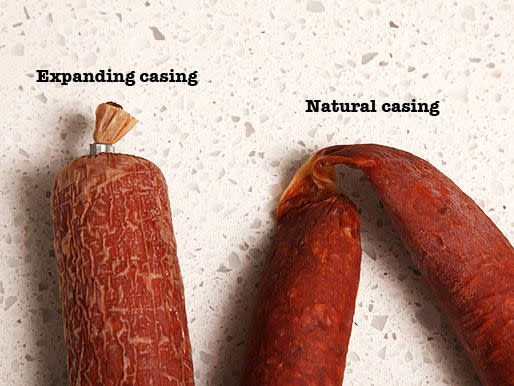
Next I cooked them side-by-side on a pizza. Indeed, the collagen-casing sticks do shrink more than the fiber casing sticks, which tend to lay completely flat, even limping a bit to conform to the contours of the crust and cheese.
But the question I had was this: Is it specifically the casing that shrinks, causing it to cup, or is it perhaps something to do with the nature of a sausage that's already been stuffed inside a natural casing? In other words, once the pepperoni is stuffed and cured, does the casing make any difference at all?
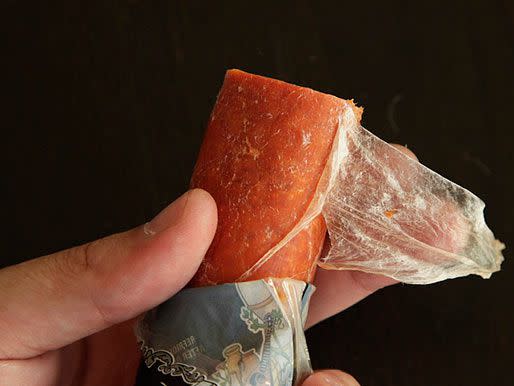
I peeled the casings off of an ezzo stick, as well as adding in a stick from Boar's Head, which uses a natural pork casing. I baked them all side by side with slices that still had their casings intact.
Guess what? Every single slice of pepperoni curled, regardless of whether or not the casing was left on.
So that's interesting. You need to make your pepperoni with a natural or collagen casing to get it to curl, but once it's been stuffed, that casing no longer plays a role. What the heck? What's special about that casing?
My next clue came from our very own Community Member meat guy, who, if you've been around these parts, is a great authority on all things sausage and meat related, having spent his life in the field. According to him:
"The meat, if stuffed using a smaller than desired stuffing horn for the casing, (casings that are in sticks generally the horn is about 1/3 of the diameter of the casing) and it is held about 1 inch back from the end of the horn. This causes the meat to flow into the casing in a U shape, so when you slice the meat, that is the pattern that is reinforced as it cooks and shrinks, causing the cup to form. When I worked for another major Pepperoni producer, our cup proof pepperoni was hand stuffed using casings that were as close to the diameter of the stuffing horn a possible creating a straight line flow and no discernible flow pattern, and the product never cupped. Other companies have cuts and holes drilled into the end of the horn to change the dynamics."
A-ha!
NB: Perhaps even more interesting than the statement above is the following: "the reason chains like it cup proof is so they don't have some yahoo suing them because they burned their mouth on the 450 Degree grease pocket in the pepperoni cup. Sort of like spilling coffee in your lap." What has society come to that we live in a world where the joy of cupped pepperoni is trumped by the fear of litigation?!
Hypothesis #3: The Fluid Dynamics of Stuffing
I called up Eric at Ezzo to inquire about Meat guy's statement, and he confirmed. "When we stuff our collagen casing pepperoni, it doesn't stretch as much, so the meat is forced down the center and sticks more to the sides. The fiber casing stretches as you stuff it, so you get an even stuffing density."
I took a length of collagen casing pepperoni generously donated by Vermont Smoke and Cure*, and sliced it in half lengthwise. According to Meat guy, I should be able to see a U-shaped meat pattern inside.
*My new favorite brand

And there it is: you can clearly see a U-shaped pattern in the meat and fat striations (in the picture above, the U dips downwards in the center of the sausage), as opposed to a fiber casing pepperoni, which shows a more homogenous mixture:

Could this be the answer I was looking for? I still had a couple of doubts, the main one being this: if the U-shaped flow pattern of meat and fat in a stick of pepperoni is what causes pepperoni to curl, how come the curl of pepperoni is not directional? That is, if we randomly place a bunch of slices of pepperoni on a pizza and bake it, shouldn't some of the slices curl up, and others curl down if the curl is based on meat flow patterns?
Or perhaps it would work that way, except for the fact that the heat differential discussed in hypothesis #1 ends up overriding its natural tendency to curl in one direction or another.
To test this, I placed slices of pepperoni on top of a paper towel-lined plate and simply microwaved them. Microwaves heat via charged electromagnetic waves that cause water molecules to vibrate. The waves can penetrate through a few millimeters of meat fairly easily, so microwaved slices of pepperoni will cook evenly throughout their volume and thus should curl in the direction they're naturally inclined to curl in, with no heat differential to get in the way.
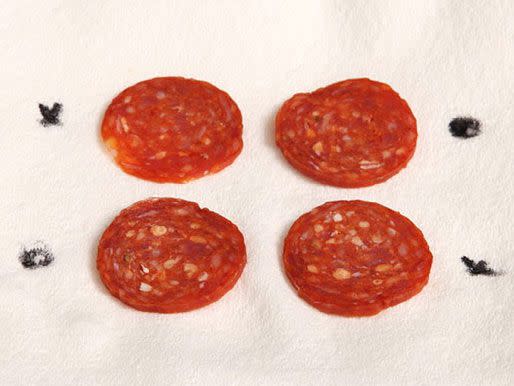
On the plate above, slices marked with an X are facing down, while slices marked with an O are facing up. I microwaved the plate for 30 seconds.
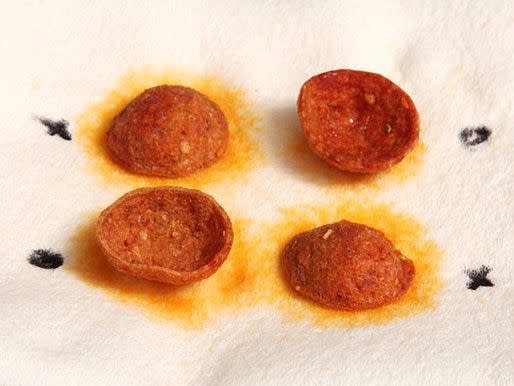
Lo and behold, the pepperoni does curl differentially! I repeated the test several more times. 48 slices of microwaved pepperoni and a shot of pepto-bismol later, I noted that every single one curled in the predicted direction, indicating that there is a good degree of truth in Hypothesis #3 as well, though heat differential overrides curl direction.
Corollary to Hypothesis #3: Drying and Density
There's another factor that should be considered when talking about cured meats: they are dried after stuffing. Since cured meat products all dry out from the outside inward, the outer layers of the stick should be dryer, and therefore denser than the center of the stick. Eventually, after the stick leaves the curing room and gets stored in a moisture-sealed plastic package for transport and storage, this moisture level will even out to a degree. I confirmed this by meticulously punching out the centers from 50 slices of pepperoni and comparing the density of the centers to that of the edges. They were virtually identical.
"moisture will evaporate from the edges faster than from the center"
However, not all moisture is moisture, as it were. Moisture that is contained within a well-emulsified sausage is bound by protein, making it difficult to escape. The moisture that migrates to the outer layers of a cured sausage during storage, however, is not bound as tightly. So upon cooking a slice of pepperoni, even though the relative density of the center and edges may be identical to start, moisture will evaporate from the edges faster than from the center, causing those edges to shrink, like a belt being cinched around your waist.
Again, microwaving the separated edges of the slices side by side with the centers of the slices and measuring their relative weight loss confirmed this.
This final factor on its own is not enough to cause significant curling—otherwise we'd see the fiber casing pepperoni curling as well—but it certainly exacerbates a slice that is already naturally inclined to curl.
Final Analysis and Conclusion

So where do we stand in the final analysis? We know of three factors that definitely affect curling:
The way the meat is stuffed into its casing affects its shape inside the pepperoni stick. For the curliest pepperoni, look for pepperoni that was stuffed into a natural or collagen casing. Whether that casing is intact or not when you cook it makes no difference at all.
The heat differential caused by uneven cooking between the top and the bottom of the slice. This enhances curl, and also determines the direction in which the pepperoni will cup. Thick slices are needed to maximize the temperature differential, but too thick and it becomes too stiff to curl. Go for slices between .1 inch (2.5 millimeter) and .225 (5.6 millimeter) range for optimal cuppage.
The moisture retention ability of the center vs. the edges of the slice will enhance cuppage, but since we have no control over this, it shouldn't affect your shopping or slicing decisions.
This entire exploration was basically just a fascinatingly roundabout way of coming to a conclusion that I think most of us already knew: For the cup-iest pepperoni, get natural casing, and slice it medium-thick.
But sometimes the journey is the destination, no?
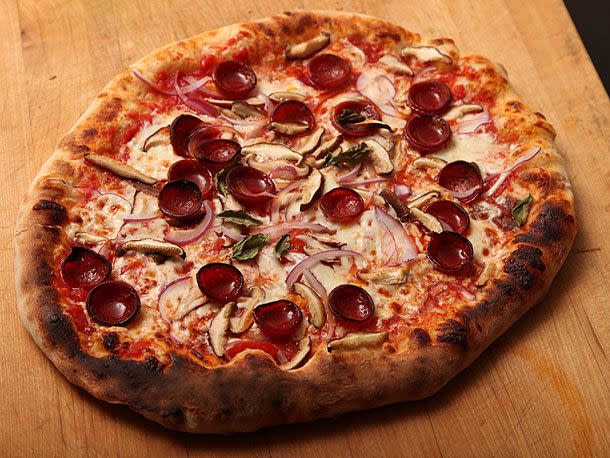
UPDATE: Pepperoni Computer Simulations
One of the benefits of having gone to a school well known for its concentration of nerds is that many of my close friends are, well, nerds. And there are few greater sources of excitement than when two separate spheres of nerd-dom collide in a synergistic orgy of geekitude. Those are truly the times when human knowledge seems to advance in leaps and bounds
A few hours after this post went live, I got an email from my friend Evros Loukaides, a research student at Cambridge University studying the behavior and applications of thin morphing structures. Apparently, curling pepperoni falls squarely in the line of his work:
"Kenji! You are dangerously close to my research topic with your latest post. As in, I'm about to forward it to my supervisor. We study the morphing capabilities of thin structures and the resulting shapes. If you are considering doing similar work about the shapes of chinese crackers, we might wanna talk to you about a joint publication. :)
If you require any computational modelling of food structures, to make your articles geekier than they already are, I'm your man."
Require? No. Really really want? You bet! I jokingly tasked him with creating a computer model of a pepperoni slice being heated on top of a pizza. An hour later, this hit my inbox:
"Challenge accepted! (sort of)
Let me start with my assumptions: I model a slice of pepperoni as a disk with a radius of 15mm and a thickness of 3mm. I start the entire model at 300°K (80°F) and apply heat as a boundary condition on the top side, until it reaches 480°K (404°F). I also apply heat on the sides and bottom but of lower magnitude.
Since the geometry is trivial, the key is knowing the properties of the material. If those are accurate, you can usually get really good approximations for reality. I'm not a material scientist—I mostly deal with the effects of geometry on structural properties. Even if I was, the mechanical properties of tissue are still only partially understood—especially if you're interested in processed meats, which contain a collection of tissues (fat, ligaments, muscle, etc.) in a casing of separate properties. So basically we'll need to make a ton of assumptions and simplifications which pretty much render the results irrelevant to reality. But hey, why not? It's all good fun.
What are the parameters we need? You already showed that conductivity of the material is significant—otherwise the directionality of the heat gradient wouldn't matter. The specific heat capacity is also relevant to this, and in turn this depends on the density of the material. The coefficient of expansion, which in this case is obviously negative is probably the controlling parameter. The Young Modulus—the stiffness of the material—will show how much it needs to move to accommodate this heat gradient. Most tissue is usually modelled as hyperelastic, but for higher temperature, this effect is reduced, and we observe almost linear behaviour. But do keep in mind that all of these parameters depend on temperature: For example intuitively you can see that dried/cooked meat is stiffer than raw meat. I'm using an elastic model here as a demonstration but of course the slice deforms plastically.
I tried to find some numbers from the literature, but they are scarce and only tangentially related to our quest. For example one reference quotes the thermal conductivity of various tissues, but for raw tissue in its natural state. Still, it gives us a rough figure."
He finished with this:
"I'll spare you the details, but by pulling numbers out of thin air in a similar manner for the remaining parameters, I was able to construct something resembling an approximation for your entertainment. If you need an accurate model, I'll need a lot more experimental data and time. And pizza."
Evros, having been to Pizza Express in Cambridge, I can only say that you deserve better pizza. I'll do my best to get it to you.